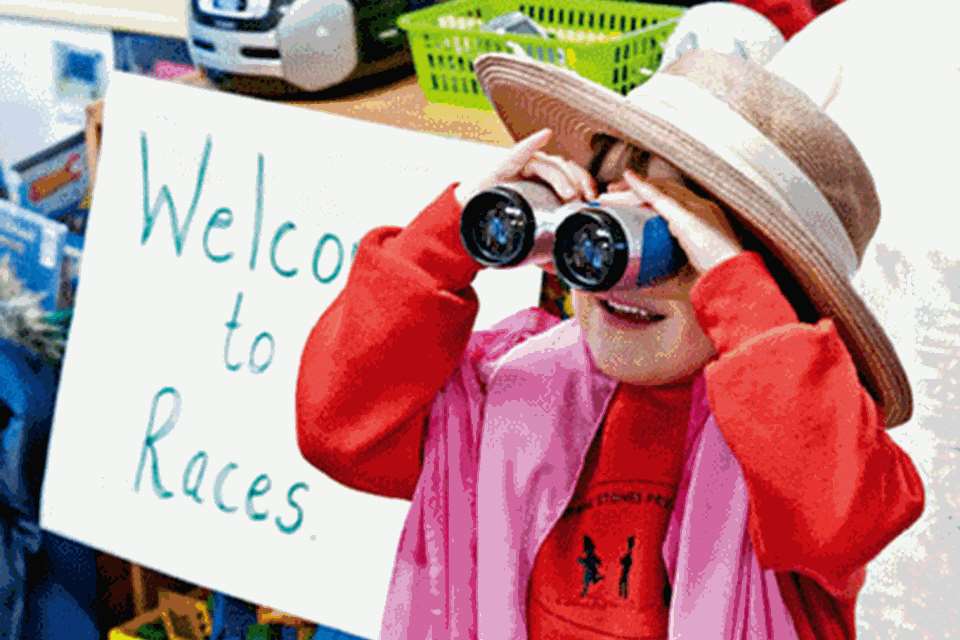Enabling Environments: Museums - In residence
Marianne Sargent
Monday, May 16, 2016
‘My Primary School is at the Museum’ is giving children the chance to learn in a uniquely enriching environment, finds Marianne Sargent

A nursery and two primary schools have been temporarily based full time at their local museum as part of a research project to test whether there may be beneficial learning, social and cultural outcomes for children and their families.
The My Primary School is at the Museum project is taking 130 nursery and primary school children directly into museums for their day-to-day programmes of lessons with the aim of offering a fundamentally different experience from the more usual occasional museum visit.
The idea for the project was conceived by Wendy James, partner of Garbers & James, an architectural practice specialising in the public cultural sector.
‘My work has increasingly specialised in education and museums,’ Ms James explains. ‘I strongly believe that there could be many creative benefits from children engaging with richly diverse object collections, for the pupils, their families, schools and museums.
‘I am delighted at the opportunity to test such a partnership model between primary schools and their local museums and to develop the knowledge and understanding we need to shape what we hope will be the partnerships of the future,’ she adds.
The project, developed in collaboration with the Cultural Institute and the Department of Education & Professional Studies at King’s College London, aims to assess the potential for the development of a new model of educational delivery whereby museums’ collections would provide the context for teaching across the curriculum.
Children would play, work and learn within a museum environment with direct access to artefacts that will have been organised and arranged specifically to enhance their learning. It is hoped that such a partnership between schools and museums could address some of the funding issues faced by both the education and museum sectors.
Katherine Bond, director of the Cultural Institute at King’s, says it is proud to be part of such innovative research. ‘It is the remit of the Cultural Institute to inspire, facilitate and support collaborations between King’s and the cultural sector that have impact beyond the university, stimulating knowledge exchange, developing research and driving innovation,’ she explains. ‘We are proud to have realised My Primary School is at the Museum, which looks set to achieve all of these things.’
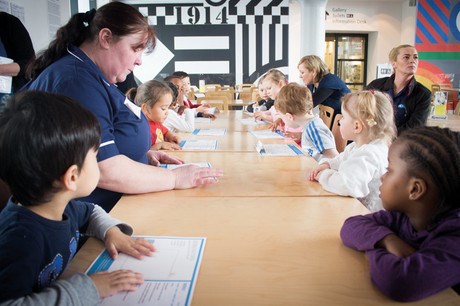
CASE STUDY: KENSINGTON CHILDREN’S CENTRE NURSERY, LIVERPOOL
Forty nursery children aged four to five from Kensington Children’s Centre were resident at Tate Liverpool for two weeks at the beginning of March. Nursery staff travelled by minibus with 12 children to the Tate at 9.30am each morning, where they were based until 3.15pm in the gallery’s Clore Learning Centre, which is comprised of a large art studio, family learning room and smaller lounge.
The daily routine was kept as natural as possible with snack and lunch at the usual times, and the children had access to similar continuous provision to that in the nursery setting. Then throughout the day they would enter the gallery to experience the art exhibitions.
Artist educator Denise Wright has worked with the children’s centre for ten years and was curriculum lead for the nursery pilot in the museum project. She says the gallery environment gave the children space and time to explore and become more deeply involved in their individual schemas for learning.
‘We already have innovative ways of learning using objects and artworks as provocations, so the children already have unusual learning experiences. But the museum just gave them that time and space to explore and really engage without many interruptions,’ she says.
‘We could see these patterns and we were able to tap into that and I think that’s really difficult to do when you have a large amount of children in the nursery that has loads of resources. Having big open spaces allowed the children to play in many different ways. They were really deeply involved and we were able to be flexible there as well so they were not rushed.’
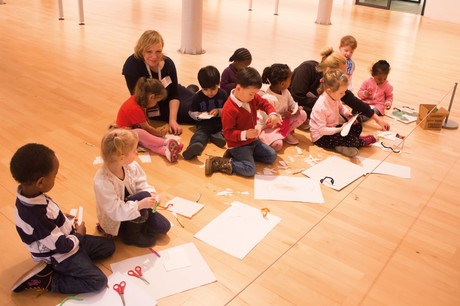
The Tate forms part of the Albert Dock on the River Mersey, and the children had views of the river from the gallery windows, which developed into an interest in boats and water and led to boat-building activities and water play. Staff then exploited a link between this interest and the children’s fascinations with patterns and shapes in gallery artwork by planning a trip on the Dazzle Ferry, which sports the colourful designs of artist Sir Peter Blake.
Miss Wright says the residency gave the children a cultural experience that they would otherwise have missed out on. ‘They really enjoyed being there. They went to a place they wouldn’t have visited otherwise. None of them had been there before. Some of their parents came along and they hadn’t been there before either. The children were going home and talking about their experience with their parents.
‘I’d definitely do it again. I think the longer we were there, the more ideas we had for what we could do. Small groups of children in such a lovely space are so animated. They’re just so much more engaged. The space is completely different and you can’t touch anything in the gallery in the Tate so they start to look and they start to experience artworks in a different way.
‘The children tap into the artists’ intentions. It’s just really lovely because I think by the time children get older, they try to make sense of everything. At that age they’re not scared of contemporary art. They just seem to understand what to do in a gallery and their interpretations of modern art are brilliant. It was a great project.’
CASE STUDY: ST THOMAS COMMUNITY PRIMARY SCHOOL, SWANSEA
The first of two Reception classes from St Thomas Community Primary School spent the half-term before Easter at the National Waterfront Museum on Swansea’s dockside. The second class is due to begin its residency in May.
The class of 27 children were transported to the museum by coach at 10am each morning and returned to school at 2.30pm. ‘We had a classroom in the museum where we taught as we normally would,’ class teacher Laura Luxton explains.
‘The helper of the day could choose what continuous provision toys we took down. I’d do a writing task at a table, a teaching assistant would do a numeracy task at a table, we had iPads, a listening station, and there would be one or two groups going around the museum with teaching assistants. Every week we had a different theme. We chose the topics based on what they had at the museum and then married the skills up just like we would in school.’
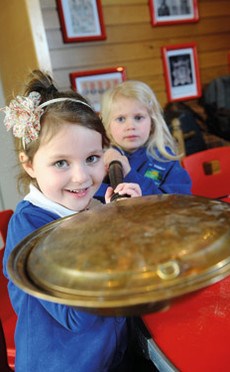
Miss Luxton describes the experience as ‘amazing’ and says that despite being exhausted at the end of each day she would do it again without hesitation.
‘I was petrified before we went, but within a week I couldn’t believe how much we were enjoying it. The opportunities were amazing. I was sceptical at first, thinking “four-year-olds for five weeks in a museum”, but we could have stayed another five. The main thing for me was seeing the confidence in the children grow. They became so independent.
‘We covered loads of different subject areas and there were loads of benefits to the curriculum, but I would say social was the biggest. We’ve got children who in the classroom at school barely talk. We’ve got children learning English as an additional language and they’ve hardly said a word since September.
‘We had marine biologists pull up in a boat where they had been trawling the river and these children who don’t say anything were handling starfish, water snails and crabs with huge smiles on their faces, confident, like different children.’
During their residency, the children benefited from workshops arranged by museum staff, received a visit from author-illustrator Thomas Docherty, visited an art gallery and took trips out to the local leisure centre for free soft-play sessions.
Miss Luxton says the experience has made her feel the need to ‘up her game’, adding, ‘We had a pirate themed week because the museum offers a pirate workshop where they get their gentleman to dress up and he acts it out with props and artefacts.
‘So they got the children to dress up and I’ve never done that before. It sounds so simple now and I think why didn’t I do that before? But they were so much more engaged because of it. I learned that when I teach a topic, to let the children get immersed in it from their side as well. It was only putting a bandana on but they thought they were pirates and they wanted to listen and learn a lot more.’
She says the school plans to continue working with the museum to help them create exhibits and activities that will appeal to younger children. ‘They want our help, asking how they can get in more families and children. We’ve got another teacher going down now who works with computers and he is going to set up a QR code trail for them and jazz it up a little bit for younger children.’
Miss Luxton says if she had the opportunity, she would take up a museum residency every year because of the huge benefits it has had for all the children in her class. ‘It taught us to value all children. You know we already do, but the children who may not achieve in maths and English at school, they were the ones who completely shone in the museum more than anybody with the hands-on activities. It was giving them that opportunity.
‘We’re struggling now,’ she laughs. ‘We’ve only been back in school since Monday and we’ve got the twitches. Where can we go next? We’ve got to get out!’
The findings of the three pilot projects, including a Year 5 class from Hadrian Primary School in South Shields (below) which was based at Arbeia Roman Fort in South Tyneside from January to Easter, will be published in the autumn.
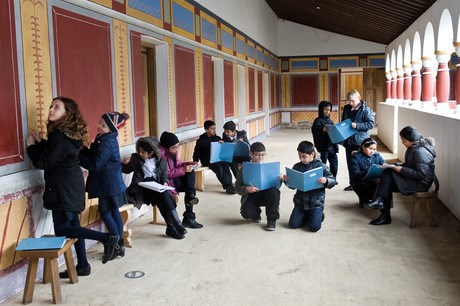
MORE INFORMATION
- Garbers & Jamesarchitects, www.garbersjames.com
- King’s College London, www.kcl.ac.uk/Cultural/-/Projects/My-Primary-School-is-at-the-Museum.aspx
- St Thomas Community Primary School, https://swansea-edunet.gov.uk/en/schools/StThomas/Pages/Default.aspx
- Kensington Children’s Centre, www.parksoptions.co.uk/kensington_childrens_centre/who_we_are
NURSERY VISITS
Child friendly
Museums and galleries are catering increasingly for the nursery-aged visitor. Check out what is available locally – you might be amazed to find out what’s on offer, as these examples illustrate:
Horniman Museum, South London, www.horniman.ac.uk
Famous for its stuffed animals, the Horniman now has furry and feathered residents that are very much alive and can be enjoyed on Animal Walks. And running to October is its family-focused exhibition Dinosaurs: Monster Families.
The Museum’s core collections of natural history, musical instruments and ethnographic artefacts are complemented by a separate Education Handling Collection containing more than 3,700 objects, including masks and puppets.
Liverpool Museums, www.liverpoolmuseums.org.uk/learning/documents/early-years-education.pdf
All Liverpool’s museums welcome nursery-aged visitors. At the World Museum, pre-school children are introduced to the world of insects through an Incy Wincy Spider story sack and a visit to the Bug House. Sessions at the Walker Gallery include Big Art for Little Artists.
National Museum of Scotland, www.nms.ac.uk
Available until June are Outer Space Magic Carpet sessions, in which nursery and primary children can dress up as astronauts and go on a journey with Space Ted. Also available are free handling boxes of artefacts and natural world specimens for children to handle and investigate.
Tullie House, Carlisle, www.tulliehouse.co.uk/your-visit/tullie-toddlers
Tullie House Museum and Art Gallery, home to collections of art, human history and natural sciences, offers toddler drop-in sessions. As well as providing a variety of crafts and creative play, the sessions now include a ‘self led’ Tullie Mouse hunt around the museum galleries. It won the 2015 Telegraph Family Friendly Museum Award.
The Whitworth, Manchester, www.whitworth.manchester.ac.uk
The Whitworth, with its extensive and eclectic collection of art and design, offers award-winning early years programmes that focus on sensory activities, designed to promote communication and early learning.
Falmouth Art Gallery, www.falmouthartgallery.com
Baby Paint, Baby Jam and Little Fingers are multi-sensory sessions available at Falmouth Art Gallery, aimed at children as young as pre-crawlers.
More destinations
More than 700 museums, galleries and historic houses have signed up to the Kids in Museums Manifesto, a practical tool designed to support institutions in making children’s, young people’s and families’ visits to museums more enjoyable. For a full list of participating places, see: http://kidsinmuseums.org.uk/manifesto-2


